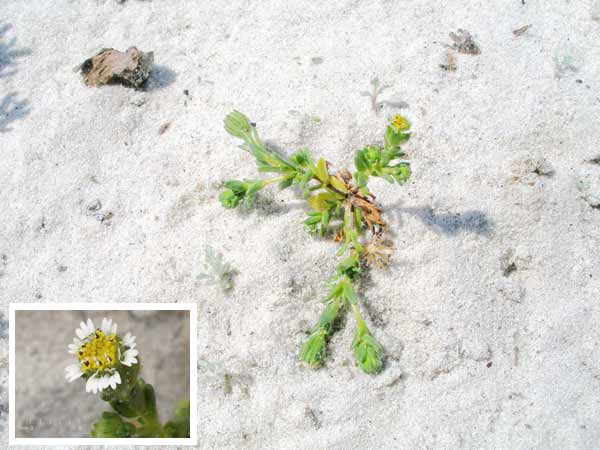CALIFORNIA'S PLANTS AND ANIMALS
California Department of Fish and Game
Habitat Conservation Planning Branch
Beach Layia
Layia carnosa
State Status: Endangered, 1990
Federal Status: Endangered, 1992
BEACH LAYIA
General Habitat: Coastal Dunes
Beach layia is a small, succulent annual herb with low spreading branches and heads of small white to pink ray flowers and yellow disk flowers. The leaves and branches have sticky glands that allow sand to adhere to the plant. This sunflower relative (Asteraceae) occurs on semi-stabilized sand in sparse coastal dune scrub vegetation.
This plant is known to occur on five dune systems along the California coastline: in northern Santa Barbara County, on the Monterey Peninsula, at Point Reyes in Marin County, and in two dune systems in Humboldt County. Beach layia has been extirpated from at least four historic sites, and was assumed extirpated from Santa Barbara County until recent discoveries of two occurrences roughly 300 yards apart on Vandenberg Air Force Base. A new occurrence with 10-15 plants was discovered in 1999 on NPS land in Humboldt County. Beach layia is now known from 20 occurrences, 12 of which are at Point Reyes National Seashore. At various sites the species occurs with other State-listed plants, including Menzies' wallflower (Erysimum menziesii) and Tidestrom's lupine (Lupinus tidestromii).
Threats include residential development, trampling, OHVs, and encroachment by non-native plants. Beach layia has shown a steady decrease in numbers since 1989 on the Lanphere-Christensen Dunes in Humboldt County, and habitat for the species is being lost to invasion by ice plant, European beachgrass, and non-native annual grasses. A number of agencies involved in a group called the Dune Forum are cooperating on a study of annual grasses and possible methods for their control. Beach layia is in particular trouble on the Monterey Peninsula, where there were less than 100 plants at last count (1989). The USFWS completed a recovery plan for beach layia and six other coastal plants in 1998.
The status in 1999 of beach layia: Declining. |
 Click flower for closeup image. (This flower is as small as the head of a kitchen match.)
Click flower for closeup image. (This flower is as small as the head of a kitchen match.)